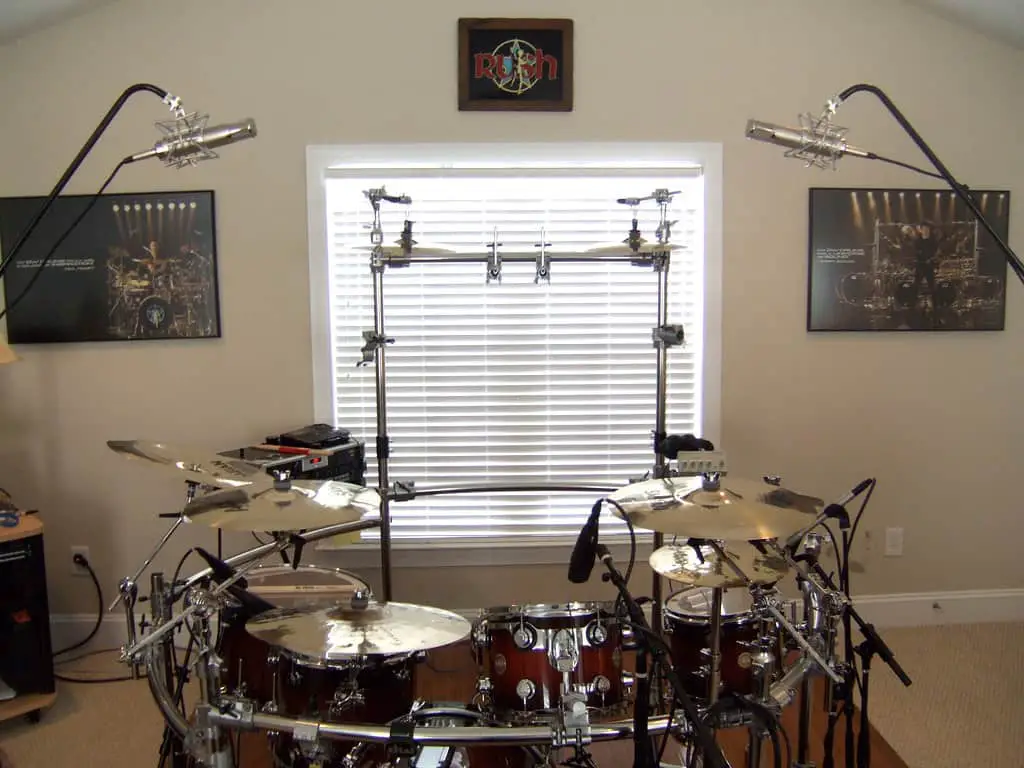The proper microphone placement for your kit should capture the variety of sounds that each one of the cymbals is capable of making, There is a variety of methods to do this. What are the Best Mic Placements for a drum Cymbal?
Use a Condenser Mic for all cymbals
6 ” off the surface
1/2 way between the Bell & the Edge
Use the Same Placement miking on the bottom
Move Mic closer to Bell adds more ping
Move Mic closer to Edge adds overtones
Keep Overheads mics at equal distance with kick & snare at the center
A few ft. above cymbals
With a half-decent mic, usually a small Diaphragm Mic, you should be able to get a variety of pro sounds off your cymbals if the placements and positions are correct. This can be done in a studio or your bedroom.
How To Mic A Ride Cymbal
Not always used by Drummers or Engineers in a studio a microphone that is dedicated to a Ride Cymbal can cut through and separate itself from the mix. A small Diaphram Condenser Mic is located 1/2 way between the Bell and the Edge on the outside half of the Ride cymbal.
This mic should be augmenting the Overheads microphones and add some definition. This mic will add the attack and definition rather than the body.
- Moving the Mic closer to the Bell will add more ping
- Moving the Mic closer to the edge will add some overtones
- In the mix, listen to Overhead soloed and you can pan the Ride Mic right to bring it forward in the stereo image.
Use the Ride Cymbal Microphone to work with the Overhead mics. Keep the microphone close enough to the Ride Cymbal to minimize bleeding from the other drums in the kit but not too close to the excessive low end that will build up.
Moving it to the edge will emphasize the overtones but this will be the job of the Overheads. The sweet spot will be different on each Drum Kit. Experiment on the exact location and how high off the Cymbal is to position the Mic.
Close Miking or Spot Miking is a very good way of making any part of the Drum Kit if the room you are in is not up to par as a professional studio might be. Placement and positioning of the Mic become critical. Move the Mic around to get the best spot.
You can angle the mic towards the Bell from the 1/2 way spot on the cymbal which will give you a little bit of both worlds. There is no wrong or right way to experiment.
Overhead Mic Placement
Depending on the sound that you are aiming for, overheads can be used to capture the sound of the kit as a whole or can be just focused on the cymbal mics. Most Drummers believe the overhead sound is important for the overall-drum sound, even if you replace all the drums you should try to keep a natural overhead sound with the natural stereo feel.
Sometimes Even if a Ride Cymbal is miked from below the cymbal the main stereo-overhead pair should remain a stereo-overhead pair for the most natural sound. Try some of these tips:
- Use Small Condenser Mics– there a little more expensive than dynamic mics.
- They are more sensitive and will reproduce the high end a lot better for not only picking up the cymbals but the drum kit with the ambiance of the room. You can use a cheaper mic but will be using more time trying to regain the higher frequencies by EQing and mixing. So use a smaller Diapragm Pencil Condenser middle of the road if you can.
- Be sure to have the pad switch on your mic, or on the console/DAW interface, set to -10 dB because the cymbals will cause the microphones to have a high output.
- Use a Hi-Pass filter on the Console or the Microphone that will eliminate some of the ambient sounds
- Pan the Left Mic far left and the Right Mic far right-4-6 feet above the kit
- If using more than one overhead mic, check the polarity between the two (as well as between the overheads and kick and snare mics) and flip the phase accordingly
Overhead Drum Mic Placement
When setting up the Overheads, what you are looking for is a nice-sounding stereo image. Start with a picture of the Kick and Snare as a mental picture of the center sound that everything else works off of.
Make sure that both Mics are at an equal distance to the Snare Drum. In a Stereo Mix, the Kick and Snare should be centered in the stereo image Mix. This will ensure you get a better mix along with the close mics you using on the Kit.
To ensure the Snare and Kick drum are even to the overheads, take a cable an XLR cable, or any kind of cable to measure the center of the Snare to the diaphragm of one mic and reach over to the other side and it should be the same length.
Hi-Hat Techniques
- The most important aspect of miking a Hi-Hat is that the diaphragm should be pointed to the source
- Positioning the Mic on the outside edge of the hat will isolate the sound of the hat from the other sounds of the kit while keeping the mic outside of the drummer’s movement.
- Pointing straight down or even off the edge of the cymbal maximizes the off-axis rejection provided by the mic’s cardioid pickup pattern
- Using a low-frequency roll-off switch can be used to further reject bleed keeping the sound full.
- Move the mic towards the Bell for a tighter sound
- For a heavier hitter-move, the mic is higher to keep control of the cymbals
Use a small diagram Condenser Mic that will be able to position close to the Hats and won’t interfere with a player’s abilities to go around the drums. It’s important that in today’s music Hi-Hats are part of the trap that a drummer comes back to more than other pieces.
Try to find a small-diaphragm mic with a side-address that can capture more sound than a normal cardioid and more options for placements.
Best Mic Placements For A Drum Cymbal
Miking Cymbals From Underneath
Another technique for miking drums that have been not talked about very much until recently is Miking Underneath a Cymbal. The mic position is on the bottom as it would be on the top surface of the cymbal. The main difference is the sonor changes it makes and the extra capacity it gives the player because of the position.
This is a very workable strategy using a clamp for miking a Hi-Hat or crash cymbal. But what about the sound? It must make the sound suck, right? That’s a matter of interpretation. I like to be honest I’ve never used it but plan to in the future.
When space is an issue in your Home Studio or practice facility, this can be a special answer to a common problem for Drummers who deal with scraped knuckles or mishits.
- The Mic stays approximately 6 ” from the top of the surface of the cymbal. Just off the Bell
- The next position is 1/2 the distance from the Bell to the edge of the edge
- The next position is the Cymbal 6″ from the Surface
You don’t seem to sacrifice too much tone as you can hear in the following video. There is a difference. The lower end carries a lower frequency. It was a little muddier or as the Drummer called it wishy-washy but I thought it sounded good. How about you? Leave us a comment.
Samples of standard Miking and Miking Underneath Technique
Samples of standard Miking and Miking Underneath Technique
Best Mic Placement For Live and Studio Banjo
Cymbal Mics
Neumann KM 184 Small Diaphragm Condenser Microphone Satin Nickel– can make a Hi-Hat Cymbals a little darker and take some over brightness out. Add some grit and make your Hats stand out and get lively. Series 180 Small-diaphragm Cardioid Studio Condenser Microphone with Windscreen – Nickel Recommended by MyWaterEarth&Sky sold through Amazon
Rode NT5-MP Compact Cardioid Condenser Microphones, Matched Pair –warm, durable has many applications at a fantastic price!

- Intended for recording acoustic instruments, drum overheads, cymbals, and live performances
- The tight cardioid pickup pattern makes it ideal for use as an indoor dialogue microphone for filmmaking on a mic stand or boom
- An interchangeable omnidirectional capsule (NT45-O) is available to expand the NT5’s versatility
Rode NT5 is A great mic for use in Overheads, any kind of Cymbal work, or an acoustic instrument. Recommended by MyWaterEarth&Sky sold through Amazon
One Mic Bluegrass Technique
JimGalloway Author/Editor

The Best Mic Placements For Drum Cymbals

